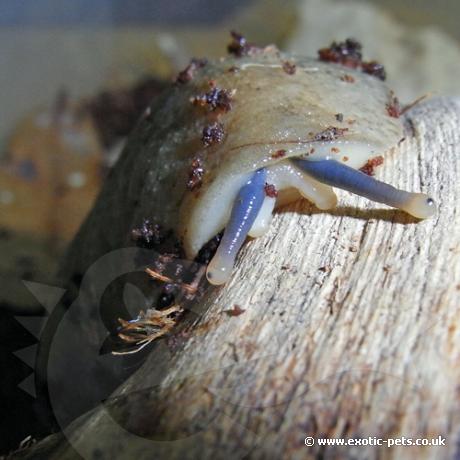

The Pancake Slug, Veronicella sloanei grows to a extended length of 12cm and is native to Jamaica. They are also found in other non-native countries where they are considered as an agricultural pest.
Adults and juveniles are alike in many ways, They have flat bodies and eyes that protude from beneath a "helmet". Coloration can be highly variable but is usually a light brown/brown colour (other colours include grey, cream and white) with 2 dorsal (back) lines running from head to tail joining at each end.
Hatchlings of this species lack colour until around the 4th day and remain a yellow cream colour until then. They have smooth skin that is sticky to the touch and can release a white 'glue' when defensive. The eyestalks are a constant bluish-grey with a light brown/tan tip, this characteristic is found only in this species of Veronicellidae making it easy to distinguish from similar species.
Adults can reach an extended length of 12cm and young slugs grow fast given the right amount of space.
Veronicella sloanei are native to Jamaica. They have since been distributed to other countries and have thrived there as an agricultural pest. Other non-native countries includes:
Barbados, Bermuda, Dominica (recently-2009), Dominican Republic, Saint Lucia, Saint Vincent, Cuba (Bahia Honda in Pinar del Río Province).
Veronicella sloanei, like most slugs, are nocturnal. They spend their days hiding under objects in the substrate and appear around dusk. Aquariums and plastic tubs are both fine to use as accommodation, a small fish tank or a 45 x 30 x 30 tub should happily house up to 4 adults (please allow a bigger tub for more adults or hatchlings). Strong, escape through lids are a must as these can fit through small gaps easily, an old pair of tights stretched over the top with a few heavy duty elastic bands holding them down make for perfect ventilation and rather escape-proof! You can always cut a large hole out of the orginial lid and place that over the tights instead though, otherwise numerous small air holes are needed (not great for hatchlings). Although this species is communal and will live happily with other veronicella sloanei, never keep other species of slug or snail with them.
As they are tropical they do prefer warmer enclosures (21C - 25C) but do not require a direct heat source (no heat mats or lights) as these can dry out the enclosure rather fast, slugs are prone to dessication (drying out) very easily so spray the tank daily with dechlorinated water (boil the water and leave to stand until cool), humidity ideally should be 80% +
Coir or a soil compost can be used (preferably no peat as it's acidic) or even a 50/50 mix of both. At least 4-6 inches of substrate is needed and it should always be kept damp but not soggy. It doesn't need to be changed regularly, once every 2-3 months is fine and never do a complete substrate change, instead just replace half the substrate with new as they are sensitive towards change. Do not worry about it getting 'dirty' as long as uneaten food is removed daily the slugs live happily in areas where bacteria thrive, that is what they are designed for.
Veronicella sloanei will eat a range of fruit and vegetables including sweet potato, chicory, lettuces, cucumber, tomato, apples, carrots, courgettes, peas, cabbages etc but nothing too acidic like lemons. They also need protein in their diets in the form of meats, pinky mice that have been left out over night are sometimes accepted, but cat/dog biscuits soaked in water do just fine. Meat and rotting meat is a part of their natural diets and protein should make up around 20% of their diets. A varied diet is key to a healthy slug!
Veronicella sloanei like to hide during the day, they will appreaciate stones, logs (from the garden, lichen covered rotting logs are prefered), plant pots, fake plants etc are fine to use.
They usually sexually mature between 7 and 10 months old, they do not have to be fully grown to be sexually mature. As they are hermaphrodites they contain both male and female reproductive organs and prefer to mate in 3's or in groups rather than in pairs. Eggs are laid in clutches of around 30-40, they are clear, oval shaped eggs which are firm but bouncy to touch. Over the days you will be able to see the development of the embryos if you hold it up to a light source. Eggs take around 15 days to hatch at room temperature and the hatchlings are a pale yellow colour with no visible markings (their colour comes around day 4) and they will hide a lot more than adults for the first week or two. Eggs are laid around once every 2- 3 weeks. If you do not wish to keep the eggs, simply freeze them. DO NOT RELEASE THEM INTO THE WILD! These are a non native species and can cause serious ecological damage, it is illegal in the UK to release them into the wild.
Not much is known about the life span of Veronicella sloanei, but they average around 2-3 years if kept correctly.